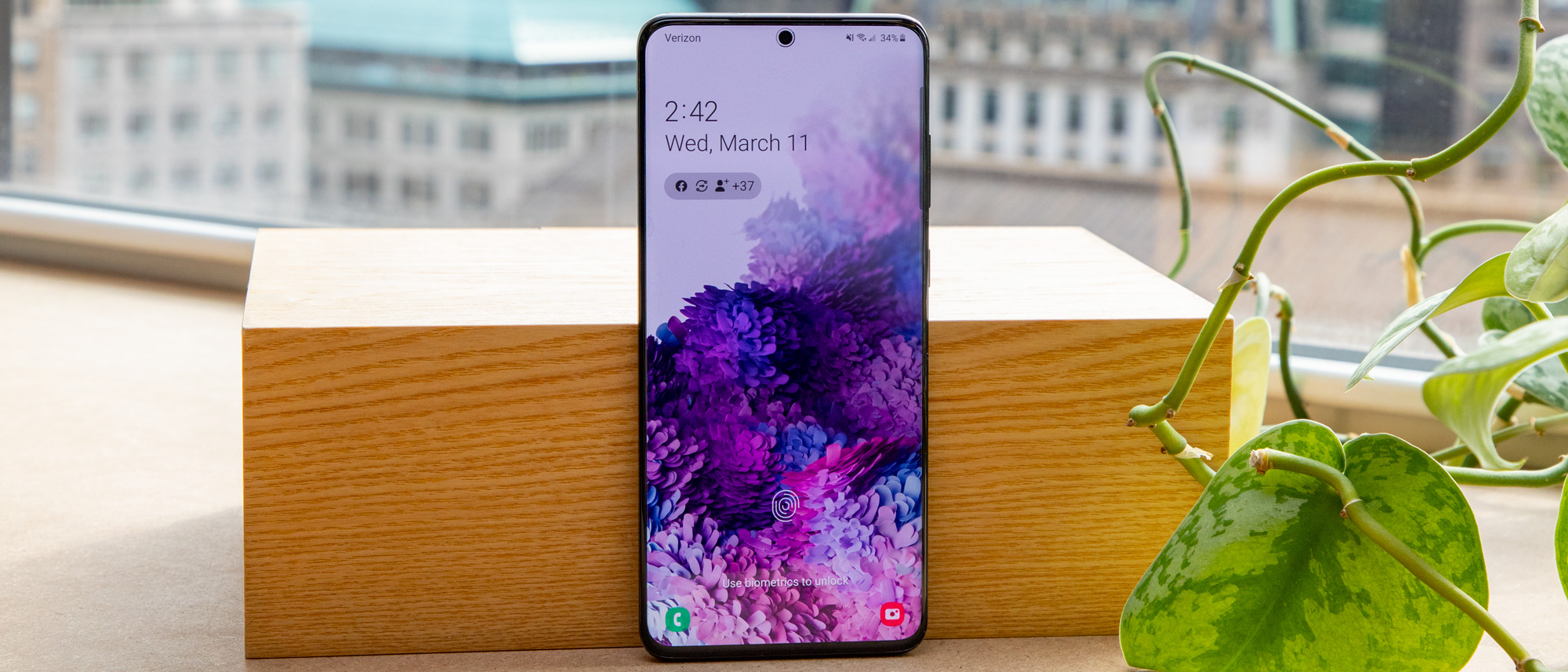TechRadar Verdict
The Samsung Galaxy S20 Plus was a nearly-perfect smartphone when it launched, connecting to more 5G networks and offering better cameras than ever, though you had to pay for the privilege, as this was the priciest Plus smartphone yet. If you don’t mind ho-hum design, the phone still handles anything you throw at it, and should last you years - especially assuming 5G networks stay compatible with the S20 Plus as they build out.
Pros
- +
Powerful yet sleek
- +
Much-improved zoom
- +
More 5G connectivity
Cons
- -
Ever-higher price
- -
Improvements are mostly iterative
- -
No more 3.5mm headphone jack
Why you can trust TechRadar
Two-minute review
At launch, the Samsung Galaxy S20 Plus was the most impressive 'middle child' handset we'd ever tested -- and most likely the best pound-for-pound S20 phone, period. It’s a powerhouse that packs the best perks of its siblings, and strikes the perfect balance between them.
That is, it’s got a bigger display and more battery life than the Samsung Galaxy S20, but it’s not quite as large and pricey as the Samsung Galaxy S20 Ultra. If you want affordability, or the best of the best, go with one of the other two; however, we predict that for most folks the S20 Plus will hit the sweet spot.
You might not want to go with any of them though, as the Samsung Galaxy S22, Samsung Galaxy S22 Plus, and Samsung Galaxy S22 Ultra have all now been released. They're upgrades in some ways and - curiously - downgrades in others, at least in the case of the standard and Plus model, so it might not be as clear cut as the Samsung Galaxy S21 Plus being the best 'Plus' option.
We've given all three Samsung Galaxy S21 phones the full review treatment too including the S20 Plus's replacement, the Samsung Galaxy S21 Plus.
Rumors are already gathering about the Samsung Galaxy S22 as well meaning this phone could feel even older soon, although there’s no confirmation of a release date just yet.
The Samsung Galaxy S20 Plus is in many ways higher end than the standard Samsung Galaxy S21, but you might want to look at the Galaxy S21 Plus instead, and for the true top Samsung flagship the Samsung Galaxy S21 Ultra is the only choice.
In any case, leaving the ultra-premium S20 Ultra aside, the Galaxy S20 Plus was also 2020's first big 5G phone – and one that operates on both the mmWave and sub-6 frequencies. Crucially, the standard S20 only works on sub-6, which means some US carriers don’t even sell that phone. In turn, that means the S20 Plus is their most affordable S20 model.
Sign up for breaking news, reviews, opinion, top tech deals, and more.
Add to the mix some truly stellar cameras featuring amped-up zoom and top-tier specs, and the S20 Plus earns its place as the best of the S20 trio. The phone isn't perfect – there are plenty of nitpicks that we’ll get into below – but it's a great all-around choice with the best of 2020's top features, though you'll have to pay to get them.
Yes, the S20 Plus has gotten a price bump over the Samsung Galaxy S10 Plus, presumably due to the added 5G compatibility. It pushes the phone to new heights of flagship prices, which is frustrating – especially given the limited availability of the cheaper 4G model, and notably the Samsung Galaxy S21 Plus actually has a lower launch price.
But if the S20 Plus pushes up the price ceiling, at least it does so as one of the best phones on the market.

Samsung Galaxy S20 Plus price and availability
- Initial release date: March 6, 2020 in the US and Australia, March 13 in the UK
- 128GB + 12GB of RAM + 5G: $1,199 / £999 / AU$1,649
- 512GB + 12GB of RAM + 5G: $1,299 / £1,099 / AU$1,899
- 128GB + 8GB of RAM + 4G only: AU$1,499 (not available in US)
The Samsung Galaxy S20 Plus was launched in the US, UK and Australia in March 2020. There are two variants of the phone; one with 5G, and another with only 4G.
The 5G version of the phone launched at $1,199 / £999 / AU$1,449 with 128GB of storage. That goes up to $1,349 / £1,099 / AU$1,699 for the 512GB model.
The 4G-only variant is available in Australia (it's not sold in the US or UK) for AU$1,299 with 128GB of storage and 8GB of RAM. All the 5G versions of the phone come with 12GB of RAM.
We reviewed the 5G version of the phone, and this review will mostly focus on that device as it's the more commonly available handset.
In other words, Samsung pitched this Plus model as more of an intermediate step than simply a larger version – which is a bit of a stretch. There aren’t that many more extras in the S20 Plus than there were in the S10 Plus that warrant the relative price jump… aside from 5G connectivity.
Whichever model you're considering, the Samsung Galaxy S20 Plus is increasingly tricky to track down now with third-party retailers keen to focus on the S21 range.
The S20 Plus comes in a plethora of cool, muted colors: Cosmic Gray, Cloud Blue, Cosmic Black, and Aura Blue. UK consumers can also get the phone in a Cloud White color, but only through the carrier O2.
- See the best Samsung Galaxy S20 Plus deals
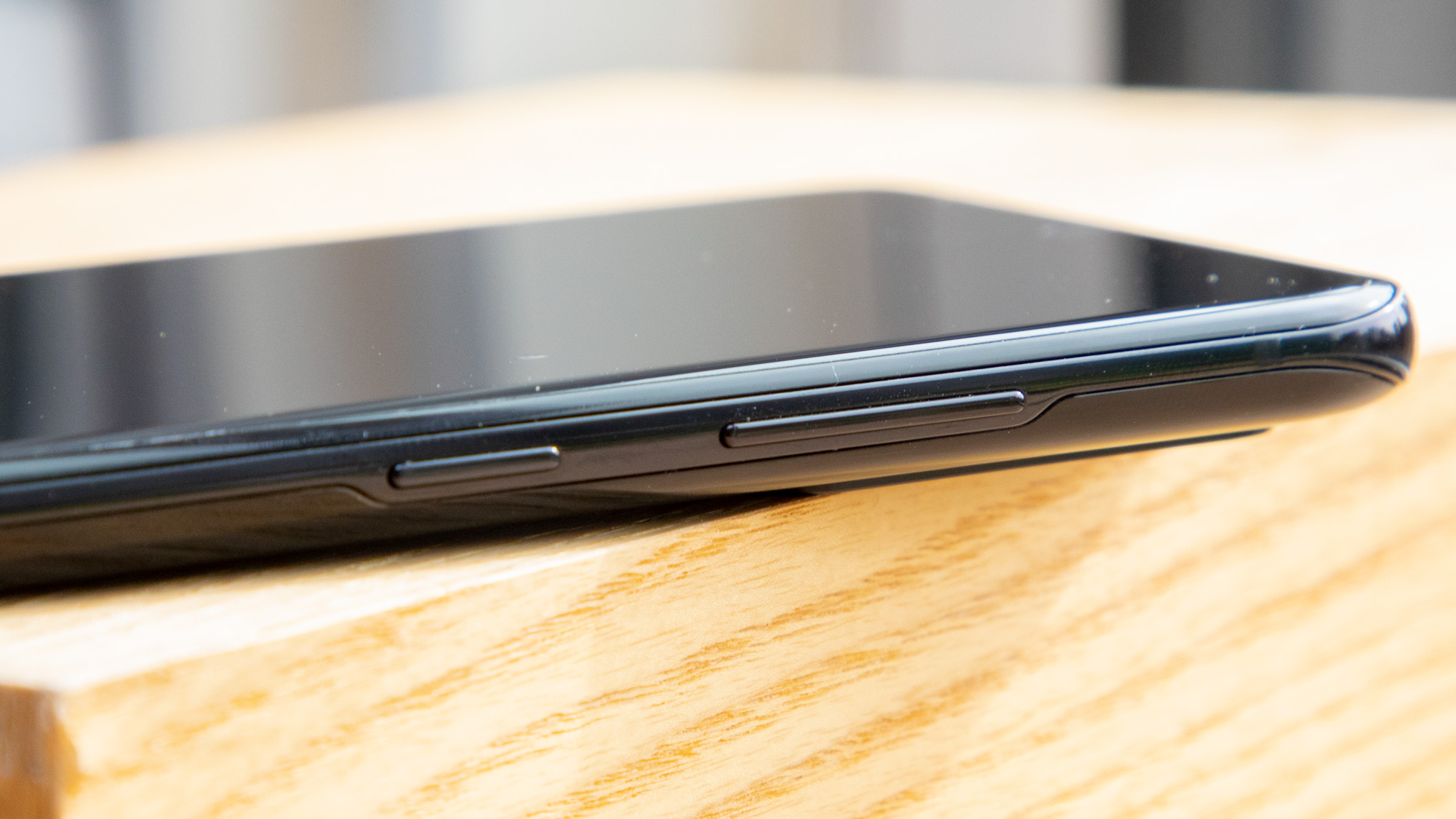
Design
- Larger than the standard S20, smaller than the S20 Ultra
- Rectangular camera block on an otherwise-sleek glass shell
- Bixby button is gone, but so is 3.5mm headphone jack
The Samsung Galaxy S20 Plus doesn’t look much different to its predecessor, but this is the sleekest device in a long line of flagships – and that isn’t a bad look.
As phone makers fumble around trying to find the best enclosure for more and more lenses, the rectangular block on the back of the S20 Plus isn’t the worst. It’s a bit more refined and less obtrusive than the square bump on the Pixel 4’s rear – although you may not think it much of an upgrade over the horizontal strip housing the cameras on the S10 Plus.
The single center-aligned punch-hole for the front-facing camera looks cleaner, and obstructs less of the display, than the lozenge-shaped cutout housing two lenses on the S10 Plus. Less noticeable unless the two phones are side-by-side is that the new Plus model has no top lip or bottom chin – its bezel is evenly sparse.
What’s likewise less obvious is how minimal the design has become: with no rear fingerprint sensor (this was dropped from all of last year’s S10 phones), no Bixby button and, sadly for some, no 3.5mm headphone jack, the S20 Plus is pretty lean.
Heck, it’s even thinner by a hair than the standard S20. The downside? Pump up the volume on the dual top-and-bottom speakers and the whole rear cover will vibrate. They put out respectable audio, though we still haven’t found sound projection and stereo balance that tops what the Google Pixel 4 is capable of.
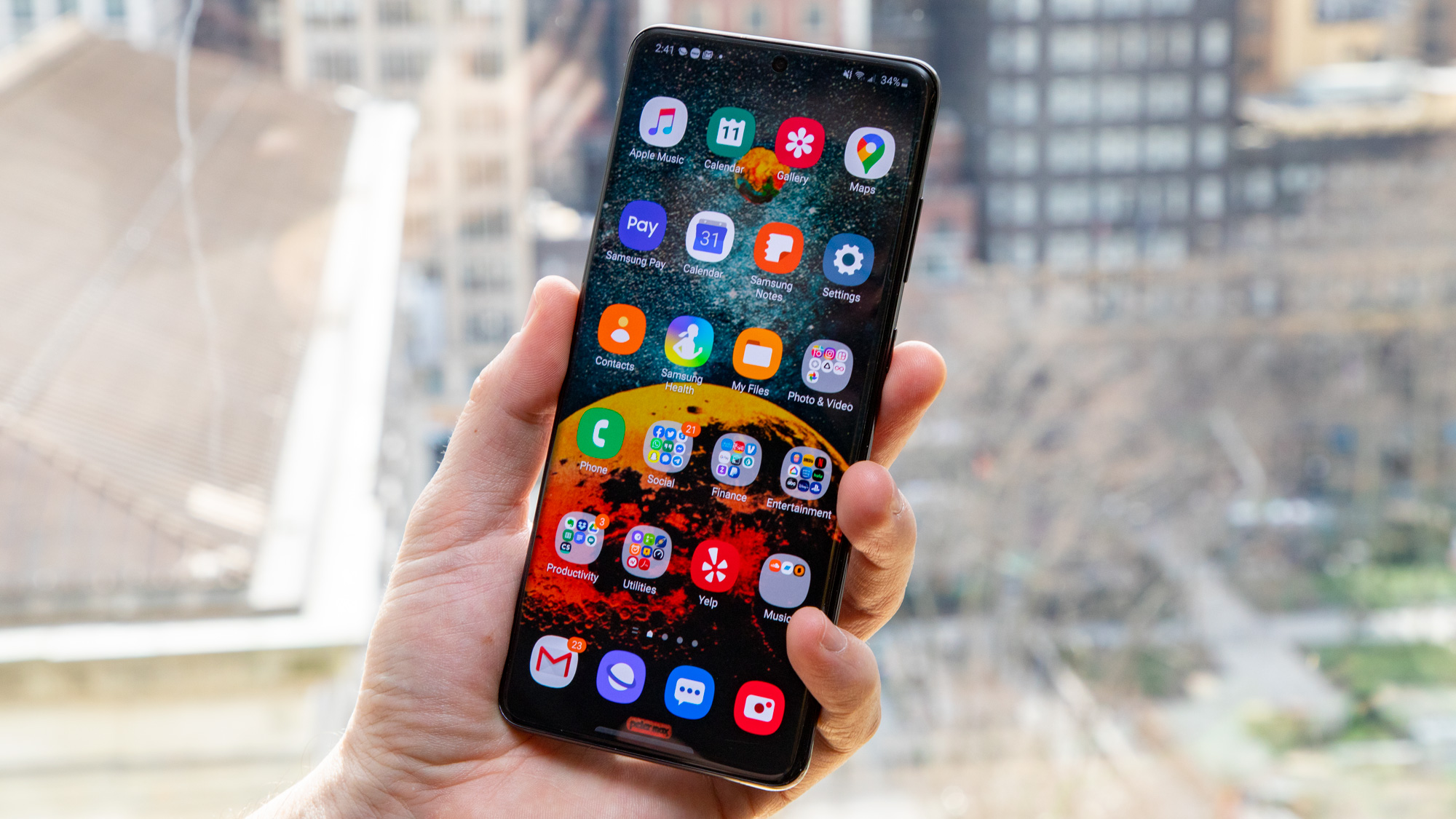
Display
- 6.7-inch AMOLED display, WQHD+ (3200 x 1440) resolution
- 120Hz refresh rate, but only at FHD+ resolution or lower
- In-screen fingerprint sensor is lackluster
The Samsung Galaxy S20 Plus’ 6.7-inch AMOLED display is sharp and vibrant, with WQHD+ resolution (3200 x 1440). The display is a shade taller than the S10 Plus’ QHD+ (3040 x 1440) screen, which is likely due to it having less bezel at the top and bottom. But you likely won’t notice a difference given how similar they are – at least until you get to the refresh rate.
Yes, the S20 phones join several other late-2019 and 2020 models in adding the option to refresh the screen more frequently. Most phones operate at 60Hz (meaning the screen refreshes 60 times per second), but on the S20 Plus and its siblings you can opt to up this to 120Hz.
While that’s a faster refresh rate than the 90Hz on the Google Pixel 4, OnePlus 7T Pro or Razer Phone 2, you likely won’t see a difference unless you put those phones side by side with the S20 Plus while it’s bumped up to 120Hz. And yes, the ASUS ROG Phone 2 also offers 120Hz, making Samsung’s flagship line the first non-gaming phones to get the cutting-edge screen tech.
So what does this mean in day-to-day use? Technically, it should enable smoother action in games that support 120Hz, although we found the effect to be more noticeable in online games like PUBG rather than action/adventure titles like Alto’s Odyssey (see this Android Authority list for other games that harness 120Hz screens). But you’ll most appreciate 120Hz in the silky-smooth animations flowing through the Android interface – yes, most of the fun is to be had flipping between apps and through menus, although you’ll get the same effect when gliding through Instagram or Twitter.
Granted, you can’t go full-throttle on both refresh rate and display resolution: if you want 1440p visuals you’ll need to set the screen to 60Hz, and if you want to bump that up to 120Hz then you’ll need to settle for 1080p (or 2400 x 1080). And you have to toggle both settings individually, which makes it too onerous for tinkering: you’ll likely set it to one combo or the other and leave it.
As for the display’s general properties, expect much the same as from the S10 Plus, with a very clear and detailed picture when watching content up to 1440p resolution. Despite technically having a higher-resolution screen than the one on the iPhone 11 Pro Max, both that phone and the S20 Plus showed roughly the same picture when demoing, say, a 1440p video on YouTube – though the Apple phone’s screen does have a slight edge in contrast, showing high-contrast subjects (like a lizard in the sun) in greater clarity.
One last point: you might want to turn on facial recognition since the in-screen fingerprint sensor is poor.
Camera
- 12MP main + 12MP ultra-wide + 64MP telephoto (3x optical)
- The latter is vastly improved, zooming up to 30x
- Shoots video in 8K 24fps...if you can find a display to show it on

The Samsung Galaxy S20 Plus packs a trio of rear cameras, plus a time-of-flight depth sensor. While the main and ultra-wide lenses haven’t changed a great deal from the corresponding lenses on the S10 Plus, Samsung has amped up the telephoto lens to deliver fantastic fidelity far beyond what its predecessor was capable of.
Where the S10 Plus packed a 12MP 2x optical telephoto camera, which extended to a respectable 10x digital zoom, the S20 Plus is rocking a 3x optical lens combined with a 64MP sensor, allowing for an astounding 30x digital zoom. Check it out below, starting with a broad photo of the Soldiers and Sailors Memorial Arch in Brooklyn, New York City - and then zooming in 10, 20, and finally 30 times.

The famous arch at the center of Brooklyn's Grand Army Plaza - here taken with the main camera.

Zoomed in 10x, which is the maximum of the S10 Plus' camera.

20x zoom of the statuary at the top of the arch.

And finally, the 30x maximum - note the blurred edges and contrast, evidence that this is a cropped zoom of a larger image.
True, the detail gets muddy at the tail end of that zoom range, but the intermediate steps – the camera app helpfully provides 2x, 4x, 10x, and 20x interval options – make it a lot easier to hone in on subjects of interest. It’s not quite the Samsung S20 Ultra’s much vaunted 100x Space Zoom, but the concept is the same – and given how rarely you’d need to get that close to a distant subject, we think 30x will suit you just fine.
Better still, at 20x and upwards there’s a picture-in-picture inset that shows which part of the larger image you’re zoomed in on – it’s a really nice touch that we expect other phone brands to copy when they get to this level of zoom capability.

Samsung has likewise boosted its Night mode with software tricks – and while our shot of the full moon at 30x digital zoom wasn’t very clear, the nocturnal mode still works at various levels of the S20 Plus’ zoom.
Samsung has packed in its regular slew of features (Live Focus, panorama, etc), along with a new one: Single Take, which is really a predictive ‘panic button’ for photography. Select the mode, hit the shutter button, and the camera will capture a selection of standard photos, depth-enhanced Live Focus stills, video, and GIF-like short animations. The best part? AI will automatically select the best images and clips and put them in a mini-album.
Stills photography aside, the S20 Plus’ other big feature (along with its siblings) is the capability to capture 8K video at 24fps. That’s far more of a showcase feature than it is a practical one, given how few commercially-available displays can actually display video in 8K, but you can drop down to UHD (aka 4K, 3840 x 2160) in 60fps, as well as FHD and regular HD if you so choose.

The S20 Plus forgoes its predecessor’s dual-lens front-facing camera array for a single 10MP shooter. Predictably, the new phone’s depth sensing is a bit off in comparison, with portrait-style Live Focus suffering a bit as software picks up the slack from the optics. Again, it’s not quite the 40MP front-facing camera on the S20 Ultra, but it gets the job done.
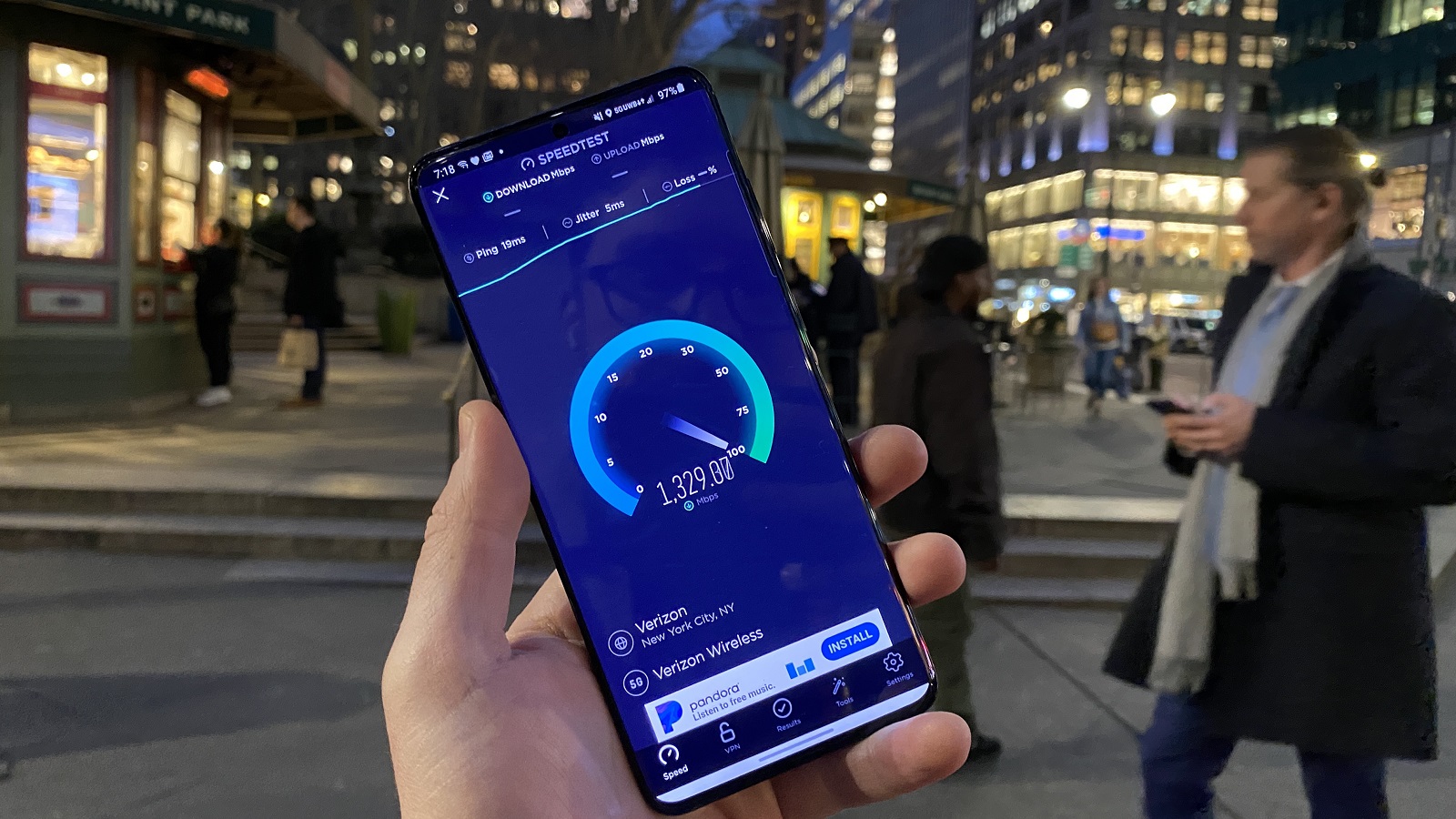
5G
- Connects to both mmWave and sub-6 frequencies
- This makes it more 5G-accessible than the standard Galaxy S20, which is sub-6 only
- Our top speed on US carrier Verizon's mmWave 5G: 1.38Gbps
The Galaxy S20 Plus connects to both mmWave and sub-6 5G networks, making it one of the first mainstream phones to do so at the time. That number has grown since but it remains an attractive option -- in theory, anyway.
That’s because we’re still in the early days of 5G, so don’t expect this expanded connectivity to be a major selling point this year as carriers build out their networks. In our New York City testing, we bounced through Verizon’s still-piecemeal mmWave 5G area, which provided impressive speeds when we didn’t accidentally step outside the coverage bubbles.
That said, having both mmWave and sub-6 makes the S20 Plus available on more carriers, especially ones that only have one or the other. Assuming carriers keep building out those networks and, crucially, in ways that maintain compatibility with the S20 Plus, the phone could be future-proofed for years to come, unlike the mmWave-only Samsung Galaxy S10 5G or sub-6-only OnePlus 7 Pro 5G.
Performance
- Snapdragon 865 chipset in the US, Exynos 990 elsewhere
- 12GB of RAM (unless you opt for the 4G-only, which has 8GB of RAM)
- 128GB or 512GB storage options
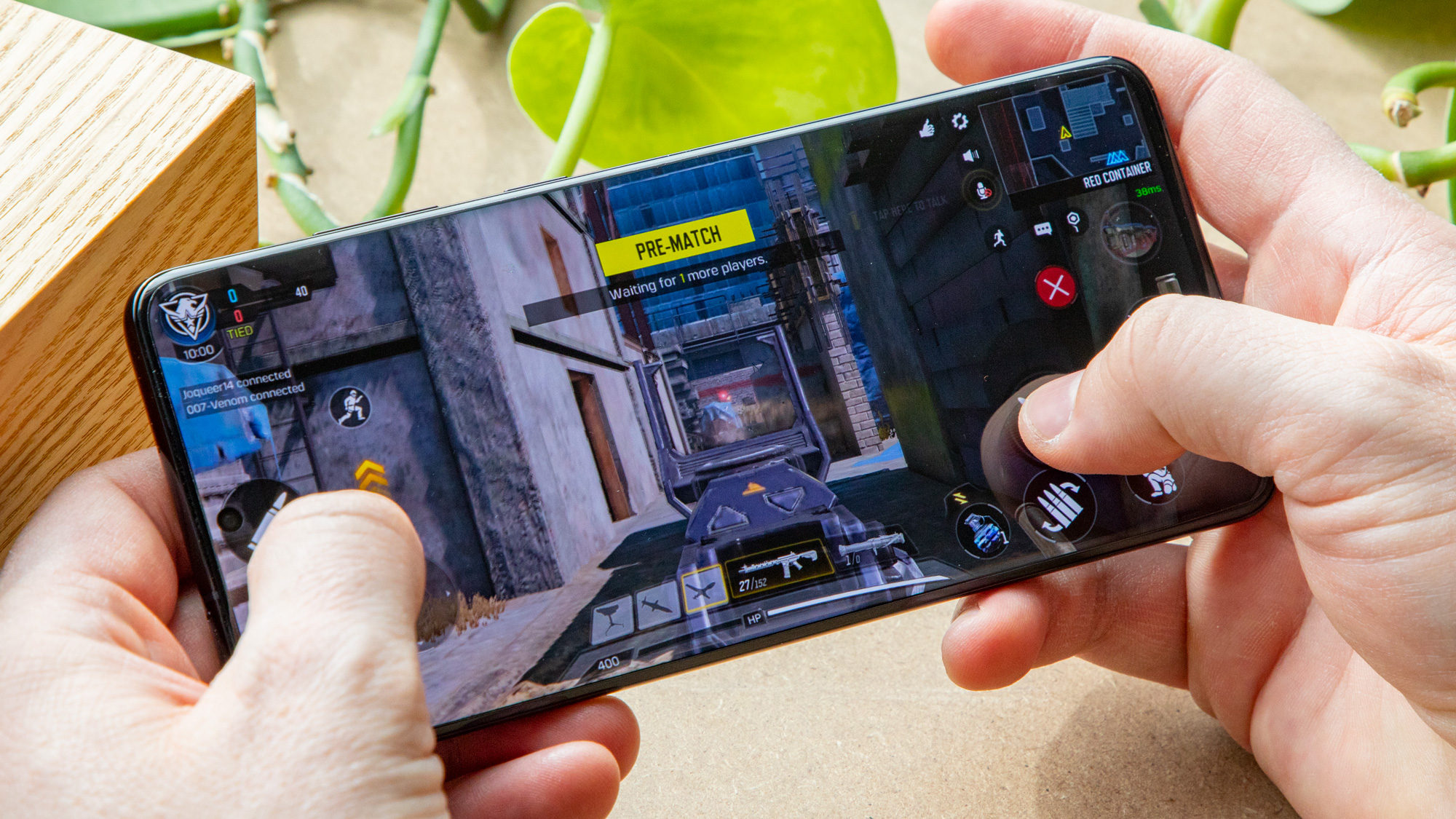
Samsung’s S-series phones have always boasted top-tier specs, and the S20 Plus is no exception. Its Qualcomm Snapdragon 865 chipset in the US or Exynos 990 in other countries (including the UK and Australia) and 12GB of RAM baseline breeze through games, media binges, and multi-app multitasking.
That's 12GB of RAM for the Galaxy S20 Plus 5G, but if you opt for the 4G version you'll get 8GB of RAM. We've yet to test that version of the device, but we believe 8GB of RAM should be enough to get you through everyday tasks.
According to Geekbench 5, the S20 Plus was one of the most powerful smartphones on the market at the time, with a multi-core CPU score of 3,034 with the Snapdragon 865 (2774 with Exynos 990) that beat most other phones while, not surprisingly, coming up short of the S20 Ultra, which scored 3,286, and also trailing the iPhone 11 Pro Max, which scored 3,424. However, when it comes to day-to-day performance you're unlikely to notice significant performance differences between similarly-priced flagship rivals.
In real-world use, the S20 Plus can handle pretty much any app, game or media you throw at it, making it a true powerhouse in your pocket. Combined with its 5G capability, this bodes well for the longevity of the handset, at least when it comes to performance.
So whether you're editing photos in Photoshop or Lightroom, or parachuting into your one-millionth round of PUBG, the Galaxy S20 Plus has the grunt to keep up. We tested it with media and games, and the phone handled everything without a problem – even when pumped up to 1440p resolution or 120Hz refresh rate, the phone didn’t heat up under pressure.
The Samsung S20 series packs Android 10 out of the box, so expect all the great features this version of Android offers, such as universal Dark Mode. Android 11 is an option too if you want to upgrade. As a Samsung phone, it has the expected brand apps and interface overlay packaged in its latest version of One UI – if the especially narrow keyboard annoys you as much as it did us, swap it out for Gboard pronto.
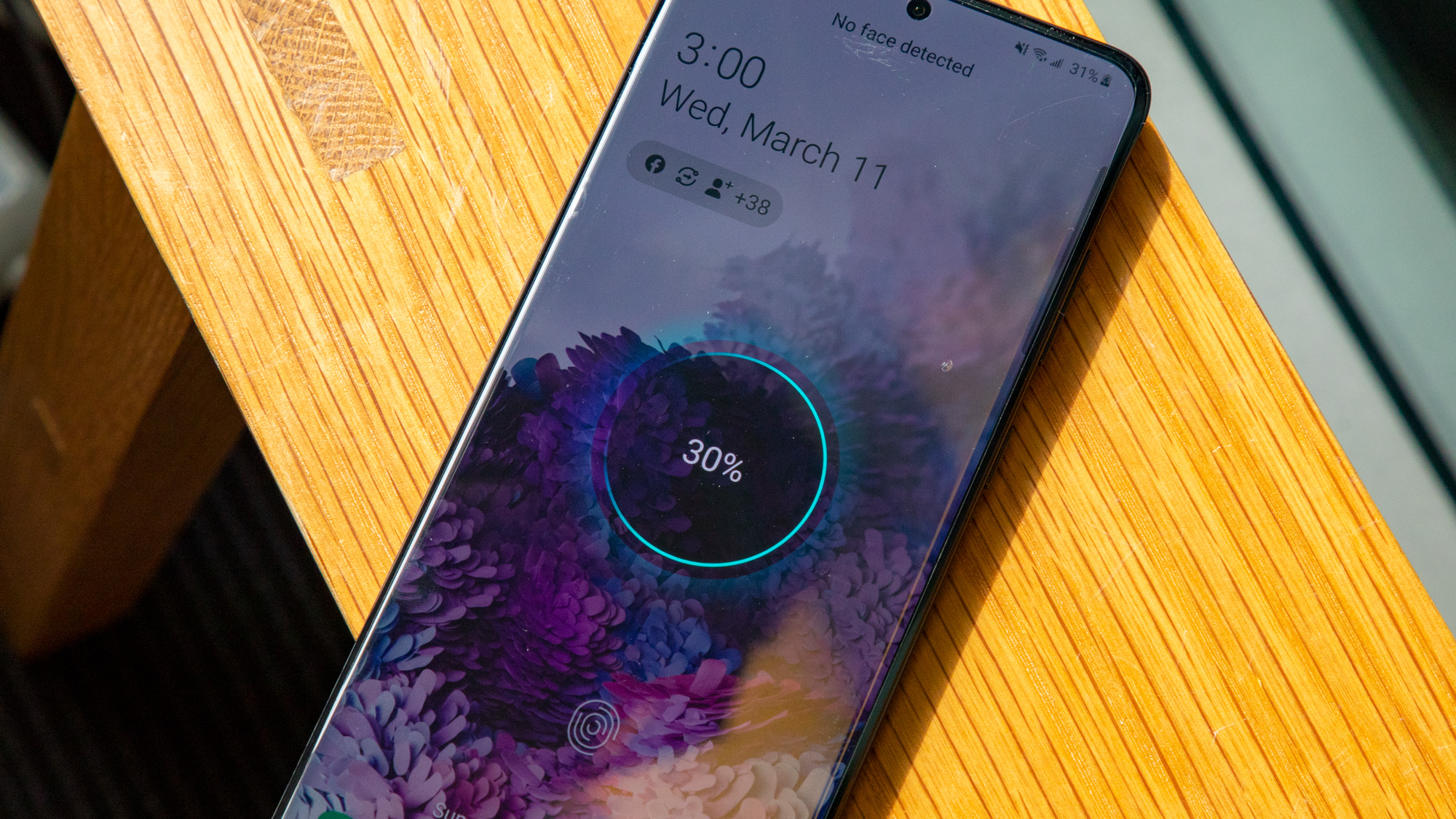
Battery life
- 4,500mAh capacity - in casual use, lasts nearly two days - though 120Hz and 5G could eat that up faster
- 25W fast charger in the box
- Fast Wireless Charging 2.0 + Wireless PowerShare to lend charge to other devices
The Samsung Galaxy S20 Plus packs a 4,500mAh battery, which feels sufficient: in our testing, we found that it held up far beyond a day’s worth of typical use, which for us included binging video, scrolling through Twitter, taking photos, and playing a few games.
That’s not especially remarkable, but it seems that battery life is more or less keeping pace with innovation: you can eke out a bit more life by reducing the display resolution or dropping the refresh rate down to 60Hz; conversely, you can max-out the screen tech that’s on offer, but battery life will suffer accordingly.
The phone includes a standard 25W USB-C Samsung charger in the box, and it also supports Fast Wireless Charging 2.0. And, like the S10 series phones before it, the S20 Plus can share its charge with other devices via Samsung’s Wireless PowerShare feature – this is particularly handy for accessories like your Samsung Galaxy Buds Plus, but it works for any device that supports Qi-charging.
Buy it if...

You’re willing to pay for nearly the best
We won’t beat around the bush: the Samsung Galaxy S20 Ultra is a superior phone, especially the cameras. But if you want to save some money, the S20 Plus has nearly all its best perks at a notably lower cost.
You love taking telephoto pictures
Not all phones are good at taking zoomed-in photos. The S20 Plus has a respectable 3x optical zoom combined with a 64MP sensor that enables some truly neat close-in photography. It may not capture the clearest photos at 30x zoom, but it will collect context at a farther range than almost every phone on the market - except for the S20 Ultra, of course.
You want to be on the cutting edge of 5G
Given the S20 Plus connects to both mmWave and sub-6 5G, it’s a great phone for those who want to jump on the cutting edge of 5G – because, chances are, the phone will hook up to the 5G network of your carrier of choice.

Don’t buy it if...
You want cheap 5G
Yes, the S20 Plus is likely the most affordable way to get 5G on both mmWave and Sub-6. But if you wanted a more affordable way to get to 5G, pick up a phone that’s 5G-capable and matching your carrier’s particular network. For instance, if your network runs on mmWave, check if there’s a discounted Samsung Galaxy S10 5G; if your network exists on a sub-6 then see if a OnePlus 7 Pro 5G works.
You want an affordable flagship
As much as we enjoyed the S20 Plus, it’s certainly expensive - and beyond the means of some consumers. If you want flagship specs at a lower cost, consider the OnePlus 7T Pro or an older phone. They’ll serve you just fine.
You want a handsome phone
If the Samsung Galaxy S20 Plus has another great flaw, it’s that its design isn’t particularly inspiring. In fact, you might be shocked its price goes so high - because all it’s paying for goes on the inside. If you can’t enjoy all the phone can do, find one which has the style and trimmings that make it worthwhile.
First reviewed: March 2020
- See our Samsung promo codes page for this month's best discounts

David is now a mobile reporter at Cnet. Formerly Mobile Editor, US for TechRadar, he covered phones, tablets, and wearables. He still thinks the iPhone 4 is the best-looking smartphone ever made. He's most interested in technology, gaming and culture – and where they overlap and change our lives. His current beat explores how our on-the-go existence is affected by new gadgets, carrier coverage expansions, and corporate strategy shifts.
